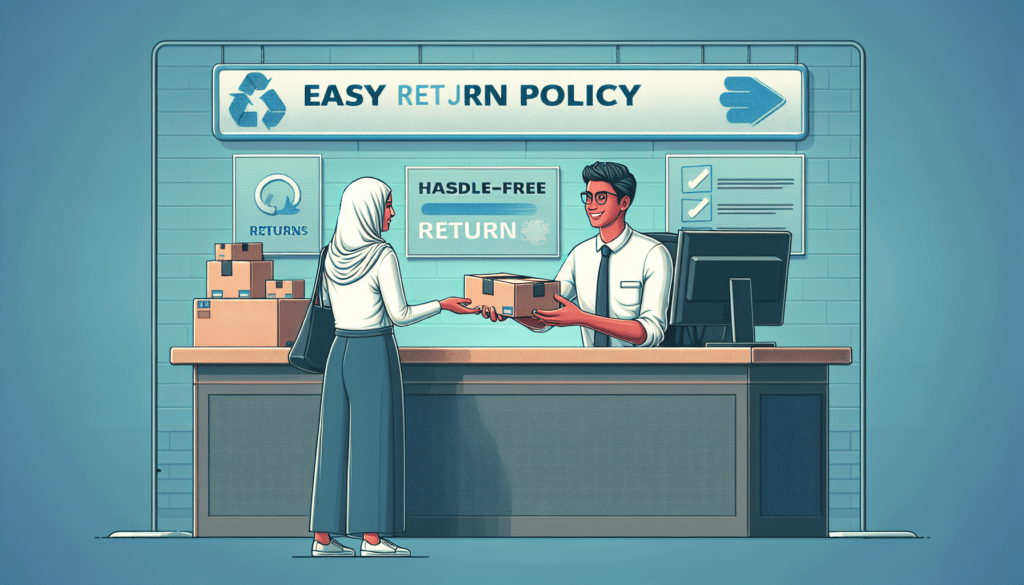In today’s consumer-centric world, understanding easy return policies has become crucial for every shopper. Whether you’re looking to buy clothes, electronics, or household items, knowing the ins and outs of return policies can save you time, money, and headaches. This comprehensive guide will walk you through everything you need to know about easy return policies, from the benefits they offer to the key elements you should look for when making a purchase. So, get ready to gain the confidence and peace of mind you deserve when shopping by delving into the world of easy return policies.

Easy Return Policies: What You Need to Know
Returning a product can sometimes be a stressful and time-consuming process. However, with the implementation of easy return policies by many retailers, this process has become more convenient and hassle-free. In this article, we will explore the benefits of easy return policies, the key features to look for, how to understand the return process, what items are eligible for return, any exceptions to these policies, the return window and timeframe, refund options, return shipping costs, and tips for a successful return. By the end of this article, you will have a comprehensive understanding of easy return policies and how they can benefit you as a customer.
Benefits of Easy Return Policies
1. Increased customer satisfaction
One of the significant benefits of easy return policies is the increased customer satisfaction it provides. When customers have the assurance that they can easily return a product if they are not satisfied, it gives them peace of mind and confidence in their purchase. This creates a positive shopping experience and fosters trust between the customer and the retailer.
2. Enhanced customer loyalty
Easy return policies also contribute to enhanced customer loyalty. When a retailer values the importance of customer satisfaction and offers hassle-free returns, it shows that they value their customers. This positive experience encourages customers to continue shopping with the retailer, leading to increased loyalty and potentially turning them into long-term customers.
3. Competitive advantage
Having easy return policies gives retailers a competitive advantage in the market. With numerous options available, customers are more likely to choose a retailer that provides convenient return processes. Offering generous return policies not only sets retailers apart from their competitors but also attracts new customers who prioritize ease of returns.
Key Features of Easy Return Policies
1. No-hassle return process
A no-hassle return process is a key feature of an easy return policy. This means that customers do not have to go through complex procedures or deal with multiple hurdles when returning a product. Instead, retailers with easy return policies provide a streamlined and user-friendly process, making it quick and easy for customers to initiate and complete their returns.
2. Generous return window
Another important feature of easy return policies is a generous return window. Retailers with easy return policies understand that customers may require some time to evaluate their purchase and decide if they want to return it. Therefore, it is common to find return windows that extend beyond the standard 30 days. This generous return window gives customers ample time to make a decision and ensures that they are not rushed into returning a product.
3. Full refund or store credit options
Easy return policies often offer customers a choice between a full refund or store credit. This flexibility allows customers to decide whether they want their money back or if they would prefer to receive store credit for future purchases. Having these options caters to different customer preferences, ensuring a positive and personalized return experience.
Understanding the Return Process
1. Initiating a return
Initiating a return is the first step in the return process. With easy return policies, retailers typically provide multiple channels for initiating a return. Customers can often choose to initiate the return online, through a dedicated customer service phone line, or in-person at a physical store location. This flexibility caters to the customer’s convenience and ease of access.
2. Packaging and shipping
Once the return has been initiated, customers need to package the item appropriately for shipping. It is essential to follow the retailer’s guidelines regarding packaging to ensure the item is protected during transit. Some retailers may provide prepaid return labels, making it even more convenient for customers to ship the item back. However, if the retailer does not provide prepaid labels, customers may need to arrange and pay for the return shipping themselves.
3. Tracking the return
Tracking the return is crucial to ensure its safe arrival back to the retailer. Most retailers with easy return policies offer tracking services, allowing customers to monitor the progress of their return shipment. This helps provide peace of mind and allows customers to have a better idea of when they can expect their refund or exchange to be processed.

Items Eligible for Return
1. Unopened and unused items
In general, unopened and unused items are eligible for return under easy return policies. This means that if you purchased an item but have not used it or opened its original packaging, you can typically return it without any issues. It is important to ensure that the product remains in its original condition and includes all the original components, tags, and packaging for a smoother return process.
2. Items with manufacturing defects
Easy return policies often cover items with manufacturing defects. If you receive a product that is faulty or has a defect due to its manufacturing, you can usually return it and receive a refund or exchange. It is crucial to document any defects or issues with the product and provide appropriate evidence, such as photographs or a detailed description, to support your return claim.
3. Damaged or incorrect items received
If you receive a damaged item or an incorrect item that differs from what you initially ordered, easy return policies typically allow for returns. Retailers understand that mistakes can happen during the order fulfillment process, and they are often willing to rectify the situation by offering a refund, exchange, or replacement. It is important to notify the retailer promptly and provide all necessary information regarding the damaged or incorrect item to initiate the return process smoothly.
Exceptions to Easy Return Policies
1. Final sale items
While easy return policies aim to be inclusive, there are often exceptions to the rule. Final sale items are typically non-returnable. Retailers designate certain products as final sale items, indicating that they cannot be returned for a refund or exchange. It is essential to check the product’s status before purchasing to ensure you are aware of any non-returnable items.
2. Custom-made or personalized items
Custom-made or personalized items are often non-returnable under easy return policies. These items are often created or tailored specifically for the customer, making it difficult for the retailer to resell them. As a result, they are usually excluded from return eligibility. Before purchasing a custom-made or personalized item, it is crucial to review the retailer’s return policy to understand their specific rules regarding these products.
3. Perishable or consumable items
Perishable or consumable items, such as food, flowers, or certain health and beauty products, are generally non-returnable due to health and safety regulations. These items have a limited shelf life and cannot be resold once they have been opened or used. Therefore, retailers typically exclude them from their return policies. To avoid disappointment, it is essential to carefully read the terms and conditions of the return policy when purchasing perishable or consumable items.

Return Window and Timeframe
1. Standard return window
The standard return window refers to the period within which a product can be returned for a refund or exchange. Under easy return policies, this window is often longer than the industry average of 30 days. Many retailers offer a return window of 60 or 90 days, providing customers with ample time to evaluate their purchase and make a decision.
2. Extended return window during holidays
During holidays, retailers often extend their return window to accommodate the increased volume of purchases made as gifts or for special occasions. This extended return window ensures that customers have enough time after the holidays to return or exchange items if needed. It is important to review the specific return policy for holiday purchases, as the extended window may differ from the standard return window.
3. Return timeframe for online purchases
Online purchases often come with specific return timeframes due to shipping and delivery times. To accommodate for potential delays or longer shipping times, retailers sometimes offer extended return timeframes for online purchases. It is essential to review the return policy for online purchases to understand the specific timeframe within which you can return the product.
Refund Options
1. Full refund
A full refund is the most common refund option offered under easy return policies. If you choose a full refund, the retailer will reimburse you for the total amount paid, including any applicable taxes and shipping fees. It is important to note that some retailers may deduct the original shipping fees from the refund amount.
2. Store credit or gift card
In addition to a full refund, many retailers offer the option of store credit or a gift card. Opting for store credit allows customers to receive the refund amount in the form of a credit, which can be used towards future purchases at the retailer’s store. Choosing a gift card provides a similar opportunity to utilize the refund amount while also offering the flexibility to gift it to someone else.
3. Exchange for a different item
Instead of a refund, some customers may prefer to exchange the returned item for a different product. Easy return policies often facilitate exchanges, allowing customers to swap the original purchase for an alternative item. This option is particularly useful if you received a defective product and would like to replace it with the same item in proper working condition.

Return Shipping Costs
1. Free return shipping
Opting for easy return policies often means enjoying the benefit of free return shipping. Many retailers cover the cost of return shipping, providing customers with a prepaid return label. This makes the return process even more convenient, as customers do not have to worry about arranging or paying for the return shipment themselves.
2. Prepaid return labels
In situations where free return shipping is not available, retailers may still provide prepaid return labels. This allows customers to benefit from discounted shipping rates negotiated by the retailer. While customers may still have to bear the cost of return shipping, prepaid return labels simplify the process by providing convenient shipping options.
3. Customer responsible for return shipping costs
In some cases, customers are responsible for the return shipping costs. If the retailer does not offer free or prepaid return labels, customers may need to arrange and pay for the return shipment themselves. It is important to consider the potential cost before initiating a return, especially for larger or heavier items that may incur higher shipping fees.
Tips for a Successful Return
1. Keep original packaging
One of the essential tips for a successful return is to keep the original packaging. Retailers often require the item to be returned in its original condition, including the original packaging, tags, and accessories. By keeping the packaging intact, you can streamline the return process and prevent any unnecessary complications or delays.
2. Follow the return guidelines
Each retailer may have specific return guidelines that need to be followed. These guidelines typically include specific instructions on how to initiate a return, how to package the item, and what documentation is required. To ensure a successful return, carefully read and follow the return guidelines provided by the retailer.
3. Insure valuable returns
For valuable items, it is recommended to insure the return shipment. This provides added protection in case the package gets lost or damaged during transit. While many retailers take responsibility for the return shipping, insuring the package adds an extra layer of security and ensures that you are properly compensated in the event of any unfortunate incidents.
In conclusion, easy return policies offer numerous benefits and convenience to customers. By understanding the key features, return process, eligible items, exceptions, return window, refund options, return shipping costs, and following helpful tips, you can have a positive and stress-free return experience. Remember to always review the specific return policy for each retailer and familiarize yourself with their guidelines to ensure a smooth and successful return.




